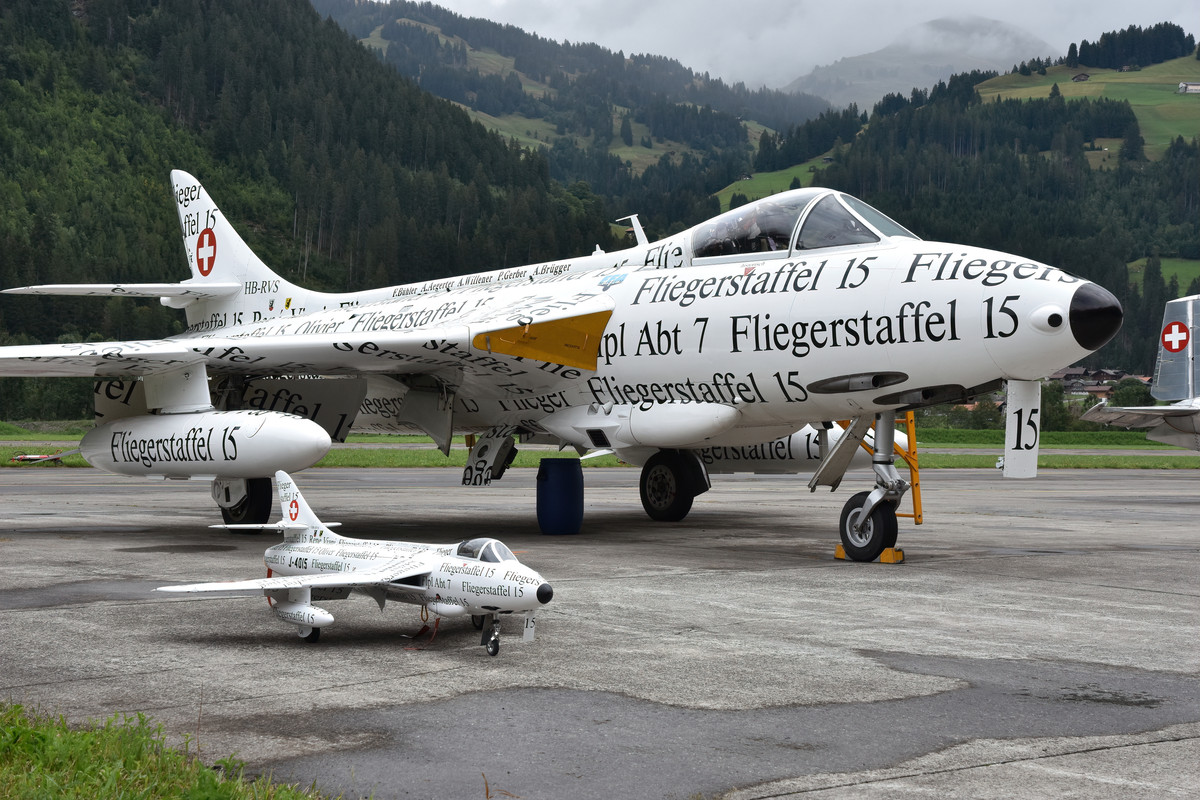
Hawker Hunter HB-RVS
About the Aircraft
The Hawker Hunter is a transonic British jet-powered fighter aircraft developed by Hawker Aircraft for the Royal Air Force (RAF) during the late 1940s and early 1950s. It was designed to leverage the advanced capabilities of the Rolls-Royce Avon turbojet engine and featured a swept-wing design, marking a significant evolution in jet fighter technology. The Hunter made history on 7 September 1953, when a modified prototype set a world airspeed record, achieving a speed of 727.63 mph (1,171.01 km/h). This aircraft was the first jet-powered design from Hawker to be procured by the RAF, and it was introduced into service in 1954 as a highly maneuverable day interceptor.
The single-seat Hunter was known for its impressive operational capabilities, quickly replacing earlier first-generation jet fighters like the Gloster Meteor and de Havilland Venom. It was equipped with four 30 mm ADEN cannons and had provisions for underwing hardpoints that allowed it to carry various munitions, including rockets and missiles. The aircraft’s design included a conventional all-metal monoplane structure with a nose-mounted radar for air-to-air gunnery. Over the years, several variants were produced, enhancing its engine performance and expanding fuel capacity. The Hunter was also notable for its participation in RAF display teams, such as the Black Arrows, and it was widely exported, serving with 21 foreign air forces throughout its operational life.
Specifications
Crew
1
Length
45 ft 10.5 in (13.983 m)
Wingspan
33 ft 8 in (10.26 m)
Height
13 ft 2 in (4.01 m)
Max Speed
715 mph (1,151 km/h; 621 kn)
Combat range
385 mi (620 km, 335 nmi)
Service Ceiling
50,000 ft (15,000 m)
Rate of climb
17,200 ft/min (87 m/s)
Historical Development
The development of the Hawker Hunter was shaped by the geopolitical landscape of the late 1940s, particularly the onset of the Cold War. Initially, the British Air Ministry adopted a cautious stance towards defense spending, believing that there would be no need for new aircraft for at least a decade. However, as tensions grew, the RAF recognized the urgent requirement for advanced fighter aircraft capable of matching the evolving threats. Responding to Specification F.43/46, Hawker’s chief designer, Sydney Camm, proposed a swept-wing jet fighter powered by the emerging Rolls-Royce Avon turbojet engine, which provided superior thrust compared to earlier models.
The Hunter’s first prototype, the P.1067, flew on 20 July 1951, and subsequent prototypes demonstrated promising performance. By 1953, the aircraft had evolved into a production standard that impressed the RAF with its capabilities, leading to its entry into service during a time of heightened military engagement, notably the Korean War. As the RAF began to receive newer supersonic interceptors, the Hunter transitioned into roles such as fighter-bomber and aerial reconnaissance. Its adaptability allowed it to remain relevant, with two-seat variants continuing to serve in training roles until the early 1990s. The Hunter’s extensive operational history included participation in numerous conflicts, and it remained in service with various operators around the world, including the Lebanese Air Force until 2014, underscoring its legacy as a versatile and enduring aircraft in military aviation history.
Did You Know?
- The Hawker Hunter was the first jet-powered aircraft produced by Hawker for the Royal Air Force, entering service in 1954.
- On September 7, 1953, a modified prototype of the Hunter set a world air speed record of 727.63 mph, which stood for less than three weeks.
- The Hunter was widely exported and served with a total of 21 air forces around the world, reflecting its global appeal and versatility.
- The aircraft transitioned from a day interceptor to a fighter-bomber and reconnaissance platform during the 1960s as newer supersonic jets entered service.
- The Hunter remained in active service for over 30 years, with some variants still operational as late as 2014.
Test Your Knowledge
1. Which engine was primarily used in the Hawker Hunter?
Performer Information
The Hawker Hunter F.58, ex Swiss Air Force J-4015, has a rich and intriguing history that encapsulates the evolution of military aviation and the enduring legacy of this iconic aircraft. Built in 1959 at the Hawker production facility in Kingston-upon-Thames, England, J-4015 was delivered to the Schweizer Luftwaffe (Swiss Air Force), where it commenced its operational life with Fliegerstaffel 15 (No. 15 Squadron) stationed at St. Stephan Air Base. Following its initial service, the aircraft was transferred to Mollis Air Base, where it continued to serve with Fliegerstaffel 20 (No. 20 Squadron) until its retirement in 1993.
After its military service concluded, J-4015 was placed in storage until it was acquired by the Hunterverein Obersimmental, a group of aviation enthusiasts dedicated to preserving the legacy of the Hawker Hunter. In 2001, they embarked on an ambitious restoration project to return the aircraft to an airworthy condition. Upon completion of the restoration, J-4015 was re-registered as HB-RVS and adorned with a striking new paint scheme featuring a dramatic white base with black newspaper lettering. This design was a tribute to the legacy of No. 15 Squadron, as it carried the symbolic serial J-4015, commemorating the squadron’s disbandment. The topside of the aircraft was further personalized with the names of various personnel who had served with the squadron, adding a layer of historical significance to its appearance.
In the same year that it returned to the skies, the Hunter made notable appearances in the United Kingdom, participating in the Hunter 50th Anniversary airshow at Kemble and the prestigious Royal International Air Tattoo (RIAT). However, shortly thereafter, the aircraft was grounded for an extensive rebuild, which kept it out of the air for several years. It eventually resumed flight operations in 2004 and continued to fly until the end of 2022, marking a remarkable chapter in its operational life.
On February 12, 2024, the Hunter Association Obersimmental officially announced that the aircraft would never fly again. This decision came after J-4015 was flown from St. Stephan to Altenrhein in October 2022 for its annual inspection, with hopes that it would return to the skies for at least one more season. Unbeknownst to all involved, this flight would turn out to be its last. J-4015 is now on permanent static display at St. Stephan, allowing future generations to appreciate its historical significance.
The grounding of J-4015, affectionately known as ‘Papyrus,’ effectively marked the end of an era for the Hawker Hunter fleet on the Swiss civil register, closing the chapter on a remarkable aircraft that had served both in military and civilian capacities for decades. Its legacy, however, will continue to inspire aviation enthusiasts and historians alike, as it stands as a testament to the enduring spirit of flight and the rich history of military aviation in Switzerland.
Inactive Status
J-4015 is no longer flying due to the decision to ground the aircraft following its last flight in 2022, coupled with maintenance considerations.


















